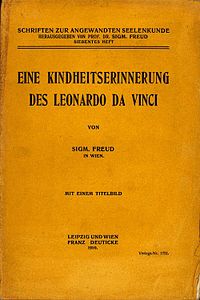Leonardo da Vinci, A Memory of His Childhood
 The German edition | |
| Author | Sigmund Freud |
|---|---|
| Original title | Eine Kindheitserinnerung des Leonardo da Vinci |
| Language | German |

Leonardo da Vinci and A Memory of His Childhood (German: Eine Kindheitserinnerung des Leonardo da Vinci) is a 1910 essay by Sigmund Freud about Leonardo da Vinci's childhood. It consists of a psychoanalytic study of Leonardo's life based on his paintings.
Interpretation
Freud provides a psychoanalytical interpretation of Leonardo's The Virgin and Child with St. Anne. According to Oskar Pfister, the Virgin's garment reveals a vulture when viewed sideways. Freud accepted this interpretation (in spite of the outlines resembling rather a duck than a vulture) as a supportive interpretation of his view of a "passive homosexual" childhood fantasy Leonardo wrote about in the Codex Atlanticus. Here, Leonardo recounts being attacked as an infant in his crib by the tail of a vulture. Freud translated the passage thus:
“It seems that it had been destined before that I should occupy myself so thoroughly with the vulture, for it comes to my mind as a very early memory, when I was still in the cradle, a vulture came down to me, he opened my mouth with his tail and struck me a few times with his tail against my lips.”[2]
According to Freud, this fantasy was based on the memory of sucking his mother's nipple. He backed up his claim with the fact that Egyptian hieroglyphs represent the mother as a vulture, because the Egyptians believed that there are no male vultures and that the females of the species are impregnated by the wind.
Translation's error
Unfortunately, the translation "Geier" (vulture), which Maria Herzfeld had used for "nibio" in 1904 in the first edition of her book Leonardo da Vinci, der Denker, Forscher und Poet,[3] was not exactly the kite Leonardo da Vinci had meant: a small hawk-like bird of prey, common in the Vinci area, which is occasionally a scavenger. This disappointed Freud because, as he confessed to Lou Andreas-Salomé in a letter of 9 February 1919, he regarded the Leonardo essay as "the only beautiful thing I have ever written".[4] Some Freudian[who?] scholars have, however, made attempts to repair the theory by incorporating the kite.
Two mothers theory
Another theory proposed by Freud attempts to explain Leonardo's fondness of depicting the Virgin Mary with St. Anne. Leonardo, who was illegitimate, was raised by his blood mother initially before being "adopted" by the wife of his father Ser Piero. The idea of depicting the Mother of God with her own mother was therefore particularly close to Leonardo's heart, because he, in a sense, had 'two mothers' himself. It is worth noting that in both versions of the composition (the Louvre painting and the London cartoon) it is hard to discern whether St. Anne is a full generation older than Mary.
Sources cited
- ^ Leonardo and Freud: An Art-Historical Study. by Meyer Schapiro in Journal of the History of Ideas, Vol. 17, No. 2 (Apr., 1956), pp. 147-178 http://www.jstor.org/stable/2707740?seq=6&Search=yes&searchText=freud&searchText=leonardo&searchText=and&list=hide&searchUri=%2Faction%2FdoBasicSearch%3FQuery%3Dfreud%2Band%2Bleonardo%26amp%3Bacc%3Don%26amp%3Bwc%3Don%26amp%3Bfc%3Doff&prevSearch=&resultsServiceName=null
- ^ translated by Abraham Brill 1916, chapter II. at bartleby.com. Freud's original German (p. 21 archive.org): «Es scheint, daß es mir schon vorher bestimmt war, mich so gründlich mit dem Geier zu befassen, denn es kommt mir als eine ganz frühe Erinnerung in den Sinn, als ich noch in der Wiege lag, ist ein Geier zu mir herabgekommen, hat mir den Mund mit seinem Schwanz geöffnet und viele Male mit diesem seinen Schwanz gegen meine Lippen gestoßen.» - Note 2: «Questo scriver si distintamente del nibio par che sia mio destino, perchè nella mia prima ricordatione della mia infantia e' mi parea che, essendo io in culla, che un nibio venissi a me e mi aprissi la bocca colla sua coda e molte volte mi percuotesse con tal coda dentro alle labbra.» (Cod. atlant., F. 65 V. nach Scognamiglio.). Cf. Nino Smiraglia Scognamiglio: Ricerche e documenti sulla giovinezza di Leonardo da Vinci, Napoli, 1900, capitulo II.1. p. 22
- ^ p. cxv books.google
- ^ "der Leonardo, das einzig Schöne, das ich je geschrieben, bereitet sich jetzt zur zweiten Auflage." Sigmund Freud - Lou Andreas-Salome - Briefwechsel, edited by Ernst Pfeiffer. S. Fischer Frankfurt/Main 1966, p. 100 books.google
See also
Further reading
- Sigmund Freud; translated by Alan Tyson; edited by James Strachey; with a biographical introduction by Peter Gay (1989). Leonardo da Vinci and a memory of his childhood (Repr. ed.). New York: Norton. ISBN 978-0-393-00149-5.
{{cite book}}:|author3=has generic name (help) - Sigmund Freud. "Eine Kindheitserinnerung des Leonardo da Vinci (1910)." Studienausgabe. Vol. 10: Bildende Kunst und Literatur. pp. 87–160, Frankfurt/Main 1969.
- Wayne Andersen. "Leonardo da Vinci and the Slip of Fools." History of European Ideas Vol. 18 No. 1, pp. 61–78, 1994.
- Wayne Andersen. Freud, Leonardo da Vinci, and the Vulture's Tail, A Refreshing Look at Leonardo's Sexuality. Other Press, New York. 2001.
